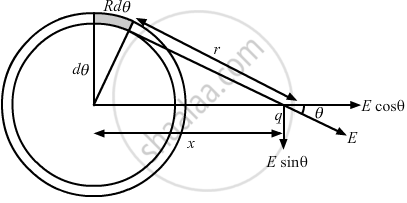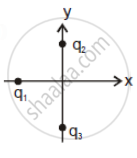Advertisements
Advertisements
प्रश्न
A positive charge Q is distributed uniformly over a circular ring of radius R. A particle of mass m, and a negative charge q, is placed on its axis at a distance x from the centre. Find the force on the particle. Assuming x << R, find the time period of oscillation of the particle if it is released from there .
उत्तर
Consider an element of angular width \[d\theta\] at a distance r from the charge q on the circular ring, as shown in the figure.

\[dE = \frac{dq}{4\pi \epsilon_0}\frac{1}{r^2}\]
\[ = \frac{\frac{Q}{2\pi}d\theta}{4\pi \epsilon_0}\frac{1}{R^2 + x^2}\]
By the symmetry, the E sinθ component of all such elements on the ring will vanish.
So, net electric field,
\[d E_{net} = dE\cos\theta = \frac{Qd\theta}{8 \pi^2 \epsilon_0 \left( R^2 + x^2 \right)^{3/2}}\]
Total force on the charged particle,
\[F = \int qd E_{net} \]
\[ = \frac{qQ}{8 \pi^2 \epsilon_0}\frac{x}{\left( R^2 + x^2 \right)^{3/2}} \int_0^{2\pi} d\theta\]
\[ = \frac{xQq}{4\pi \epsilon_0 \left( R^2 + x^2 \right)^{3/2}}\]
According to the question,
\[x < < R\]
\[F = \frac{Qq x}{4\pi \epsilon_0 R^3}\]
Comparing this with the condition of simple harmonic motion, we get
\[F = m \omega^2 x\]
\[ \Rightarrow m \omega^2 = \frac{Qq}{4\pi \epsilon_0 R^3}\]
\[ \Rightarrow m \left( \frac{2\pi}{T} \right)^2 = \frac{Qq}{4\pi \epsilon_0 R^3}\]
\[ \Rightarrow T = \left[ \frac{16 \pi^3 \epsilon_0 m R^3}{Qq} \right]^{1/2}\]
APPEARS IN
संबंधित प्रश्न
A polythene piece rubbed with wool is found to have a negative charge of 3 × 10−7 C.
(a) Estimate the number of electrons transferred (from which to which?)
(b) Is there a transfer of mass from wool to polythene?
How does Ampere-Maxwell law explain the flow of current through a capacitor when it is being charged by a battery?
Write the expression for the displacement current in terms of the rate of change of electric flux.
A point charge is brought inside an electric field. The electric field at a nearby point
(a) will increase if the charge is positive
(b) will decrease if the charge is negative
(c) may increase if the charge is positive
(d) may decrease if the charge is negative
A proton and an electron are placed in a uniform electric field.
A point charge q is placed in a cavity in a metal block. If a charge Q is brought outside the metal, will the charge q feel an electric fore?
A long cylindrical volume contains a uniformly distributed charge of density ρ. Find the electric field at a point P inside the cylindrical volume at a distance x from its axis (see the figure).

A smple pendulum consists of a small sphere of mass m suspended by a thread of length l. The sphere carries a positive charge q. The pendulum is placed in a uniform electric field of strength E directed vertically downwards. Find the period of oscillation of the pendulum due to the electrostatic force acting on the sphere, neglecting the effect of the gravitational force.
In figure two positive charges q2 and q3 fixed along the y-axis, exert a net electric force in the + x-direction on a charge q1 fixed along the x-axis. If a positive charge Q is added at (x, 0), the force on q1 ______.
(1) |
(2) |
Assertion: The positive charge particle is placed in front of a spherical uncharged conductor. The number of lines of forces terminating on the sphere will be more than those emerging from it.
Reason: The surface charge density at a point on the sphere nearest to the point charge will be negative and maximum in magnitude compared to other points on the sphere.
When a glass rod is rubbed with silk, it ______.
Which of the following graphs shows the variation of electric field E due to a hollow spherical conductor of radius R as a function of distance from the centre of the sphere?
Which one of the following is the unit of electric charge?
Given below are two statements:
- Statement I: The electric force changes the speed of the charged particle and hence changes its kinetic energy; whereas the magnetic force does not change the kinetic energy of the charged particle.
- Statement II: The electric force accelerates the positively charged particle perpendicular to the direction of the electric field. The magnetic force accelerates the moving charged particle along the direction of the magnetic field.
In light of the above statements, choose the most appropriate answer from the options given below.
A charge of magnitude 3e and mass 2m is moving in an electric field E. The acceleration imparted to the charge is ______.
The potential at a point x (measured in µm) due to some charges situated on the X-axis is given by v(x) = `20/((x^2 - 4)` V. The electric field E at x = 4 µm is given by ______.
